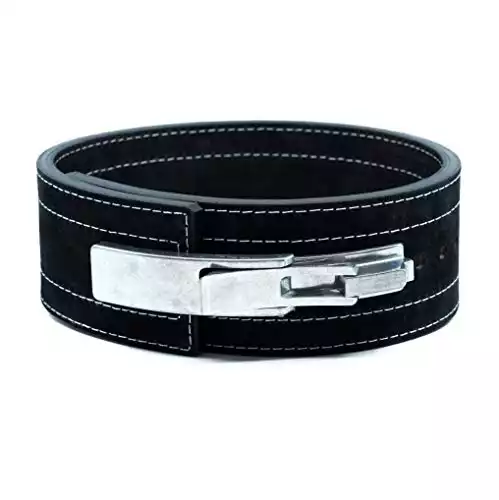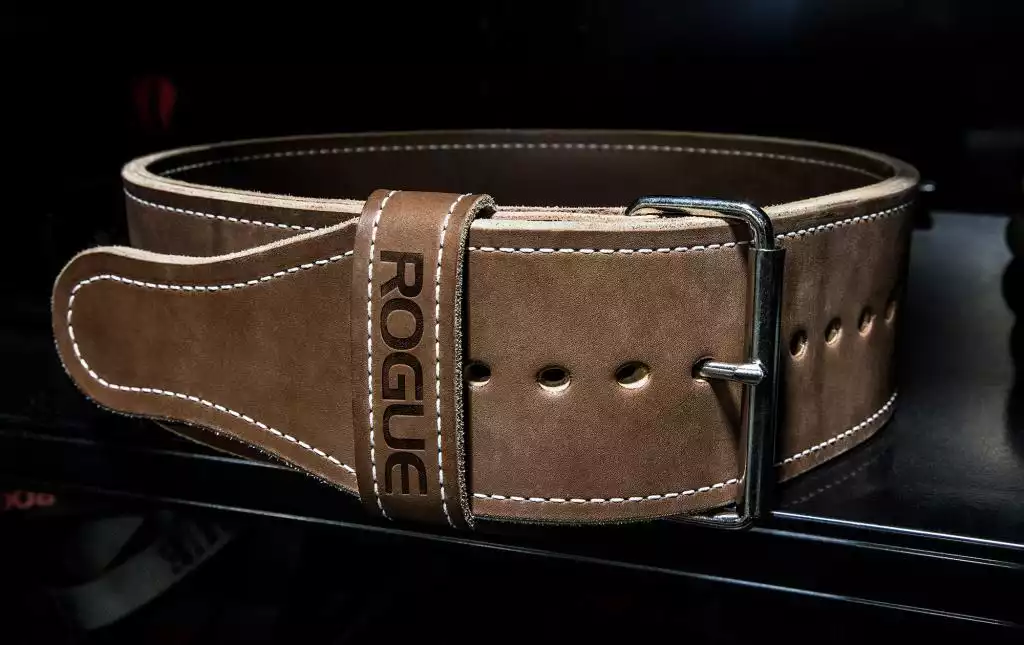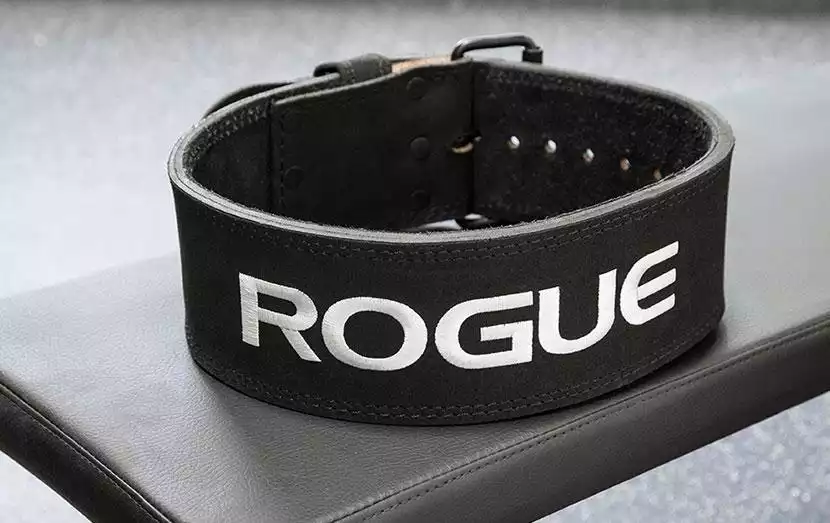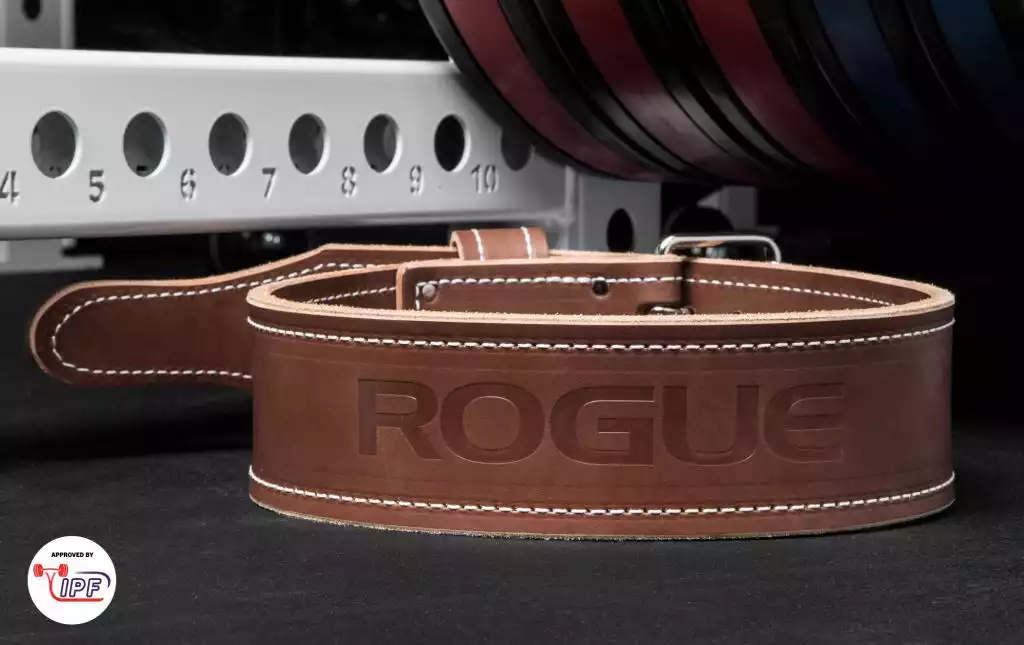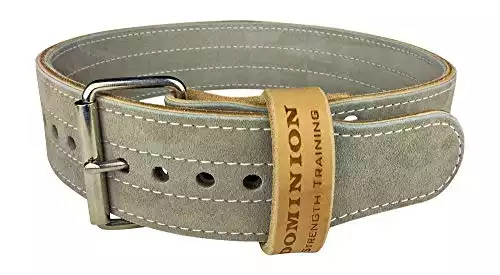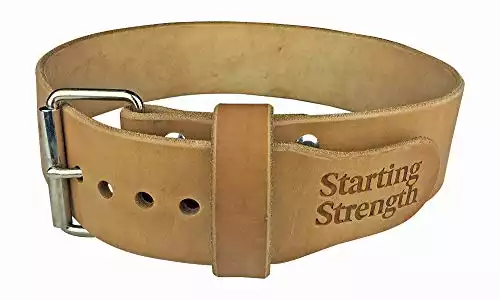Some links in this article are affiliate links, which means I earn from qualifying purchases.
In the world of powerlifting, belts help you break plateaus and increase strength.
The width of a powerlifting belt is the measurement at the back of the belt.
There are two sizes for powerlifting belts: 3-inches or 4-inches.
But what does one inch do in terms of your workout and lifts?
Well, it depends on many factors and the difference can result in a good workout or a poor one.
So is the 3 or 4-inch powerlifting belt best for you? The 4-inch powerlifting belt is the most popular size among lifters. It provides superior comfort and is flexible enough for all types of workouts. The 3-inch powerlifting belt is only best for shorter lifters and those with a small torso, including women. If you are a bench press specialist, the 3-inch powerlifting belt will also be better for you.
For most serious lifters, the 4-inch powerlifting belt is perfect. But if you want to get a complete breakdown, let's get into it.
In a Hurry? Here’s My Recommendation
For most lifters, I recommend you get a 4-inch powerlifting belt. This width is ideal for most powerlifters in the sport.
The best 4-inch powerlifting belt on the market is the Inzer Forever Lever belt by IAD. Many powerlifters swear by this belt and it comes with a lifetime replacement warranty.
A Top Choice For Powerlifters
Considered to be the standard in lifting belts, the Inzer Forever Belt comes with a lifetime guarantee. At 10mm and 4-inch width, its superb build quality and material make it ideal for all types of lifters.
The width is an important factor for lifters but not difficult to decide. Let's breakdown the differences between 3-inch and 4-inch powerlifting belts.
How to Choose Between 3 Or 4-Inch Powerlifting Belts
If you ask any lifter about this topic, they will recommend the 4-inch belt over the others at all times.
But then again, if this were the case, why would 3-inch belts be produced and sold in the gym world?
There are some important factors to consider when choosing the width of your powerlifting belt.
For those of you looking to buy your first lifting belts, I recommend taking a look at my article on choosing a lifting belt.
Types of Lifts
Depending on your type of workout, a smaller powerlifting belt will be more suitable for you.
Some of you may prefer over head movements for lifts. For these types of lifts, you need more torso coverage to progress higher in lfits. The extra coverage on your torso and back will help keep your upper body straight. So, a wider powerlifting belt will do.
There are some lifters who are bench press specialists. Now there is very little information on the science of lifting belts. But, anecdotal experience shows these lifter prefer smaller belts.
Why?
The bench press specialist doesn't need mid back coverage. They only need a lower back support belt. In fact, in powerlifting, your mid back arch is critical. With a wider belt, your arch is limited and so is your lifting ability.
Are You Planning To Compete?
Only certain types of equipment are allowed during competitions. Each specification has to line up with the standards or guidelines in place.
The International Powerlifting Federation allows 4-inch powerlifting belts. This width is the most commonly used one by competitive powerlifters.
Calorie Intake
The next factor to consider is your nutritional requirements daily.
If you are looking to put on weight, a shorter width belt will eventually start to yield poor coverage on your back and core.
With more weight gain, your waist line will most likely increase and you'll have to adjust your smaller lifting belt up and down during lifts. So a 4-inch powerlifting belt will suit you better in the long term.
Now, if you're cutting your calories, a smaller belt may not be beneficial. This comes to my next point.
Your Size
If you're a shorter lifter, then choosing anything related to wearing can be difficult. I would know. I'm 5'6" on a good day.
With a powerlifting belt, a 4-inch width may be too big for you. This highly depends on your torso height. If your torso is smaller, you will experience pinching and digging of the belt into your hips.
Further, women powerlifters will also experience discomfort with wider belts due to their heights. So, keep your anatomy in mind when choosing your powerlifting belt.
You may also be looking to gain weight or have a larger mid section. In this case, a wider powerlifting belt would be great.
So, let’s see what benefits there are to be reaped from 4-inch powerlifting belts.
4-Inch Powerlifting Belts
The 4-inch powerlifting belt is the most popular size among lifters and in many strength sports. Even among manufacturers, the 4-inch version is the most popular and comes in various styles and colors.
Benefits Of 4-Inch Powerlifting Belts
The 4-inch powerlifting belts are the most popular types out there.
If your ‘rib cage to upper hip’ distance exceeds 3 inches, this type of belt will be your best option by far.
The extra width of this equipment will provide you with all the back support that you need, including the superior side of your torso.
The benefits for 4-inch powerlifting belts include:
Who Should Use 4-Inch Powerlifting Belts
To go more in-depth, here are some categories of people for which the 4-inch powerlifting belt is great.
Lifters Looking To Lift More
Those of you looking to go heavier in the gym need superior support for stability. The heavier loads will challenge your balance and ability to keep correct posture.
The extra coverage of a 4-inch lifting belt will help support your back and core.
You may feel as if your torso is small right now, and, thus, inadequate for a 4-inch belt, but do keep in mind that, as your progression with heavier weights starts to show in your back muscles, you are going to gain some serious size.
You'll be able to progress further in squats, deadlifts, and even some rowing exercises. The 4-inch powerlifting belt should be ideal for Strongman, powerlifters, and weightlifters alike.
Larger Lifters
Larger individuals, with a large width between the upper hip and the rib cage, should consider 4-inch powerlifting belts.
They would lack the necessary mid-back support to fully optimize the exercises with a smaller belt. If problems related to chafing or discomfort arise, you should be looking at padded 4-inch belts, or belts with softer material. The width is not your problem here.
If you're heavier than 150lbs for women and 200lbs for men, you'll benefit from using a 4-inch belt.
Labour Workers
If your job involves continuous heavy labor such as a fireman or construction worker you will benefit from a 4 inch powerlifting belt. With the added stability and bracing ability, you can lift more without worrying about back issues.
Further, in a job requiring constant movement and not strict lifts, the 4 inch width will let you move freely. One of the most common lifting belts on the market is made for general laborers.
First Time Belt Users
As a first time lifter, I didn't know what to purchase for my first lifting belt. But luckily, the width is not too difficult of an option to chose from.
Start off with the 4-inch powerlifting belt. You'll have time to get used to this width and grow in size over time. Further, if you're not happy with a 4-inch lifting belt, you can always switch to a smaller one.
Competitive Lifters
Ultimately, the 4-inch belt is fit for competitive and recreational powerlifters alike, as it is the closest you can get to a ‘one-size-fits-all’ solution.
These belts are competition-approved, and you should not have any issues in competing with it, nor will it bring any trouble by simply using it in the gym recreationally.
Basically, every category of lifters can use the 4-inch lifting belt but some are suited better for 3-inch versions.
The Best 4-inch Powerlifting Belts
After hours of research, the best powerlifting belts with 4-inch widths are:
1. Inzer Forever Belt
A Top Choice For Powerlifters
Considered to be the standard in lifting belts, the Inzer Forever Belt comes with a lifetime guarantee. At 10mm and 4-inch width, its superb build quality and material make it ideal for all types of lifters.
Even though there are many options on the market to choose from, the Inzer Forever Lever Belt is the best option out of them all.
The material is very resistant, the design is user-friendly, and it also has a lever closing mechanism, which I think is the best for powerlifting and weightlifting belts.
You even get a lifetime warranty in case of breaking or tearing, showing just how confident these people are in their craft. Many powerlifters swear by this belt and you'll notice them during meets and competitions.
2. Rogue Ohio Powerlifting Belt
Another option that I feel is worth noting is the Rogue Ohio Powerlifting Belt.
Why?
Because, even though it is a 4-inch belt, the design of the upper side is made so that the ‘digging’ effect is minimized. That means your rib cage won’t feel as much discomfort as with a classic 4-inch belt.
So, if your torso length is borderline, or you are not sure about your potential growth over time, this is a safe option.
3. Rogue Echo Lifting Belt
Ultimately, the Rogue Echo Lifting Belt is another solid option for those looking for more stiffness in their belts. The leather is very durable, though it can take a while to break in, but the benefits are there nonetheless.
Additionally, it has one of the best price-to-quality ratios out there, which may be a strong plus for those on a tight budget.
3-Inch Powerlifting Belts
A 3-inch powerlifting belt is not as common as the 4-inch variant. However, there are still lifters who prefer them. Specifically, lifters with shorter torsos, women, and bench pressers like the width of these powerlifting belts.
Benefits Of 3-Inch Powerlifting Belts
There are some definite benefits to 3-inch powerlifting belts:
Who Should Use 3-inch Powerlifting Belts
The 3-inch powerlifting belt gets a bad wrap. Some lifters think the belt can only be used rarely. But in fact, there are a few lifters and situations where you would benefit from the smaller width.
1. Shorter Lifters
In the case of people with small torsos, a 4-inch belt may be uncomfortable, in that it can dig into one’s rib cage during exercise.
From first-hand accounts with lifters who have this problem, I can safely say that this is a kind of pain that you don’t want to have around during your gym time.
What does a ‘small torso’ mean, exactly?
Well, if the distance between your rib cage and the upper part of your hip is 2-2.5 inches, you fit in this category. You may want to look into the 3-inch powerlifting belts.
If it goes beyond this range, you probably won’t have any issue with the 4-inch belt.
Hold on. If the belt is 4-inch, and my distance is of 3 inches, won’t it also be causing discomfort? There’s an entire inch to be considered there.
No, not really. This is because your belt is supposed to be residing partially on the top of the hip for optimal support.
If you want to see exactly how to put on a weightlifting belt for the best support of your core, check out our in-depth guide here.
2. Bench Press Specialists
The second category of people benefiting from a 3-inch belt is that of bench-press specialists.
In the case of bench-presses, a lifter only needs to heavily support his or her lower back, as the arching movement is an absolute must in this case. Thus, a 4-inch belt would make arching rather uncomfortable and more rigid than a 3-inch one.
If you are looking to become a bench-press specialist, or have enough money to spend to get differentiated belts for your exercises, then the 3-inch belt may be a wise investment on your part.
3. CrossFitters
Due to the smaller size of 3-inch lifting belts, you can get more range of motion during Olympic movements.
CrossFitters will truly enjoy the freedom of a smaller size lifting belt during their workouts. You'll experience easier movement going from deadlifts to muscle ups in the same workout.
Going through multiple different types of lifts in one workout can be uncomfortable when wearing a bulky lifting belt. You might even start getting deep jabs in your hip and waist area.
The Best 3-Inch Powerlifting Belts
There are a few good 3-inch powerlifting belts on the market. Here are the top 3:
1. Rogue 3-Inch Ohio Belt
The Rogue 3-Inch Ohio Belt is a fantastic fit and the best option on the market.
Most lifters who use smaller belts swear by this option wholeheartedly, as it is made from high-quality leather and will last a long time.
2. Dominion Strength Training Powerlifting Belt
The Dominion Strength Training Powerlifting belt is also another 3-inch belt for shorter lifters. Many users love using the belt for deadlifts and other hip hinge type movements.
Although it comes in one color, it is a single prong belt built to last. It comes with a lifetime warranty and is made in the USA.
3. Starting Strength Powerlifting Belt
The Starting Strength Powerlifting Belt comes from famed coach and trainer Mark Rippetoe.
Made from durable leather and built from one single piece of hide. The belt has a single prong smooth buckle that makes using the belt very easy. The overall quality and build of this 3-inch belt is comparable to Rogue for a lower price.
Other Factors to Consider
Once you know what width to buy for your powerlifting belt, you need to choose other options to get the perfect fit.
Size Of Your Lifting Belt
Once you know what width to buy for your powerlifting belt, you need to choose other options to get the perfect fit.
Size your lifting belt quickly and accurately with this guide.
Belt Thickness
The thickness of your powerlifting belt can vary as well. The market has two options, 10mm or 13mm. Most people will prefer the 10mm belt because its easier to break in and suits most lifters needs.
Check out my 10mm vs. 13mm article for a detailed comparison between the two belt thicknesses.
Closure Mechanism
For the fastening of your powerlifting belt, you can choose prong or lever versions. Most people prefer the lever belt for ease of use and quality.
Frequently Asked Questions
How Thick Should My Powerlifting Belt Be?
If you're a casual lifter and don't plan to get to an elite level of strength, the 10mm thickness is more than enough for your needs. At 10mm, the lifting belt will provide stability and not hinder gains by being uncomfortable. A 13mm lifting belt will provide you an increase in gains but only for elite lifters looking to squeeze out gains.
How Do You Break In A Powerlifting Belt
Buying a leather powerlifting belt will require some time to break in and get comfortable. The best way to break in a powerlifting belt is to wear it as often as you can. There are other options such as bending it and molding it to soften the leather.
Here is a detailed guide on breaking in your powerlifting belt.
Should I Get A 3 Or 4-Inch Powerlifting Belt?
The width of your lifting belt determines how much of your abdomen is covered while wearing the belt. A 4-inch powerlifting belt is good for most lifters and will help you progress in strength numbers. If you're a shorter lifter or a woman with a smaller torso, a 3-inch powerlifting belt will be better.
Final Thoughts
All in all, this is pretty much everything that you need to know about belt width before making a purchase. The problems that arise for lifters with smaller builds are real, so don’t just go on following the mainstream 4-inch belt bandwagon if you don’t fit those categories.
It’s better to accept these differences than to feel ashamed of size or anything else as such. Choosing between a 3 or 4-inch powerlifting belt is simple enough.
Remember to wear your equipment properly, and to smash those PRs starting tomorrow!
A Top Choice For Powerlifters
Considered to be the standard in lifting belts, the Inzer Forever Belt comes with a lifetime guarantee. At 10mm and 4-inch width, its superb build quality and material make it ideal for all types of lifters.
DISCLAIMER: This article is for intended for educational purposes only and not as an individualized exercise prescription, therefore no one can be held liable in the occurrence of injuries, damages or monetary losses as a result of the information.
References
Harman EA, Rosenstein RM, Frykman PN, Nigro GA. Effects of a belt on intra-abdominal pressure during weight lifting. Med Sci Sports Exerc. 1989 Apr;21(2):186-90. PMID: 2709981.
Lander JE, Hundley JR, Simonton RL. The effectiveness of weight-belts during multiple repetitions of the squat exercise. Med Sci Sports Exerc. 1992 May;24(5):603-9. PMID: 1533266.
Lander JE, Simonton RL, Giacobbe JK. The effectiveness of weight-belts during the squat exercise. Med Sci Sports Exerc. 1990 Feb;22(1):117-26. PMID: 2304406.

